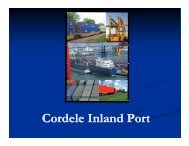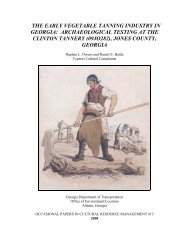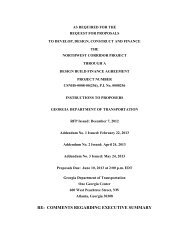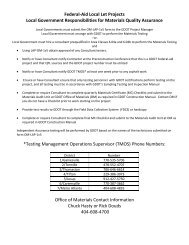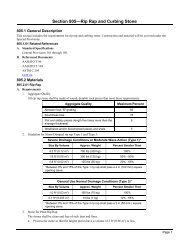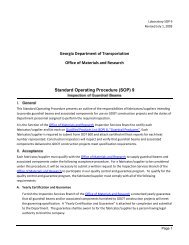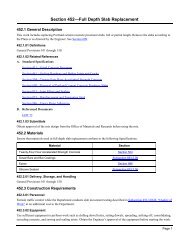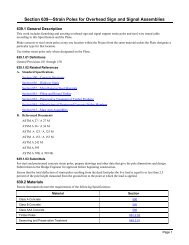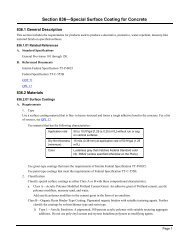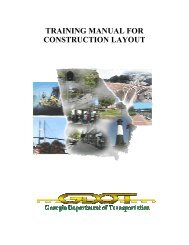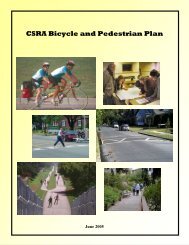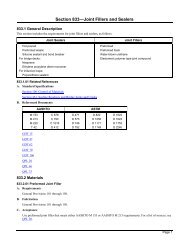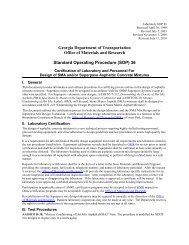Section 820 - Asphalt Cement
Section 820 - Asphalt Cement
Section 820 - Asphalt Cement
You also want an ePaper? Increase the reach of your titles
YUMPU automatically turns print PDFs into web optimized ePapers that Google loves.
DEPARTMENT OF TRANSPORTATION<br />
STATE OF GEORGIA<br />
Delete <strong>Section</strong> <strong>820</strong> and substitute the following:<br />
SPECIAL PROVISION<br />
<strong>Section</strong> <strong>820</strong>—<strong>Asphalt</strong> <strong>Cement</strong><br />
<strong>820</strong>.1 General Description<br />
This section includes the requirements for asphalt cements prepared from crude petroleum.<br />
<strong>820</strong>.1.01 Related References<br />
A. Standard Specifications<br />
General Provisions 101 through 150.<br />
B. Referenced Documents<br />
Standard Operating Procedure (SOP 4)<br />
AASHTO R 28<br />
AASHTO T 48<br />
AASHTO T 179<br />
AASHTO T 240<br />
AASHTO T 313<br />
AASHTO T 314<br />
AASHTO T 315<br />
AASHTO T 316<br />
AASHTO TP70 / ASTM D7405<br />
<strong>820</strong>.2 Materials<br />
<strong>820</strong>.2.01 <strong>Asphalt</strong> <strong>Cement</strong><br />
A. Requirements<br />
1. Type<br />
August 30, 2007<br />
Revised: November 3, 2008<br />
Revised: March 18, 2009<br />
Revised: April 29, 2010<br />
Revised: March 21, 2012<br />
Revised July 13, 2012<br />
First Use: December 14, 2012<br />
Use a material homogenous and water-free and will not foam when heated to 347 °F (175 °C).<br />
Ensure blend used to produce a specified performance grade meets the following requirements:<br />
Is uniform and homogeneous without separation<br />
Uses PG 64-22 or PG 67-22 described below for the base asphalt<br />
Consists of production materials not being “air-blown”.<br />
Contains < 0.5% acid (including Polyphosphoric Acid (PPA) modification, when approved by the<br />
Office of Materials and Research).
2. Grade<br />
Use the various grades of asphalt cement meeting the requirements shown in the test requirements for<br />
Petroleum <strong>Asphalt</strong> <strong>Cement</strong>s.<br />
Add Styrene-Butadiene-Styrene (SBS) or Styrene-Butadiene (SB) to neat asphalt to produce a binder<br />
meeting requirements for PG 76-22 when roadway ADT is equal to or greater than 100,000 for Stone<br />
Matrix <strong>Asphalt</strong> and Porous European Mix (PEM) or Open Graded Friction Course (OGFC) Mixtures.<br />
Styrene Butadiene Rubber (SBS) or Crumb rubber modified PG 76-22 is an acceptable alternative to SBS<br />
or SB modified asphalt cement at contractor’s discretion, when roadway ADT is less than 100,000,<br />
provided the SBR or crumb rubber modified asphalt cement meets the tests’ requirements of PG 76-22. For<br />
SBR modified PG 64-22 or PG 67-22 to meet PG 76-22, use only SBR currently approved on QPL-65<br />
“Georgia’s List of Approved Latex Suppliers”. For crumb rubber modified PG 64-22 or PG 67-22 to meet<br />
PG 76-22, use 30 mesh size ambient or cryogenic ground tire rubber at minimum 10% of weight of total<br />
asphalt cement content. Ensure Trans-Polyoctenamer is added at 4.5% of the weight of the crumb rubber to<br />
achieve better particle distribution. Varying percentage blends of crumb rubber and approved additives may<br />
be used, at the discretion of the Office of Materials and Research, provided the end product meets all<br />
specified requirements of PG76-22 including Phase Angle. Ensure the end product is homogenous and<br />
shows no separation or coagulation. Percentage of ambient or cryogenic ground tire rubber is neat asphalt<br />
source dependent to meet specification requirements for PG 76-22.<br />
The maximum Phase Angle requirement is not applicable to the crumb rubber modified PG 76-22<br />
incorporating ≥ 10% crumb rubber with approved additive equivalent to 4.5% of crumb rubber (see notes f,<br />
g, i and j).<br />
Test And Method<br />
Flash Point, Min.,<br />
AASHTO T 48<br />
Viscosity, Max.,<br />
AASHTO T 316,<br />
(Note a)<br />
Mass Loss (%), Max.,<br />
AASHTO T 240,<br />
(Note b)<br />
Dynamic Shear, G*/sin<br />
, AASHTO T 315,<br />
10 Rad/Sec<br />
Dissipated Energy,<br />
Dynamic Shear, G*sin<br />
, AASHTO T 315,<br />
10 Rad/Sec<br />
Creep Stiffness,<br />
60 sec., AASHTO T<br />
313, (Note c)<br />
Direct Tension, 1.0<br />
mm/min., AASHTO<br />
T314, Failure Strain<br />
Multiple Stress Creep &<br />
Recovery (MSCR) test,<br />
ASTM D7405, AASHTO<br />
TP70 (proposed), Jnr 3.2<br />
kPa, (Notes f, g, i and j)<br />
Polymer Separation<br />
Test<br />
ASTM D7173<br />
AASHTO T53<br />
Softening Point (ºF)<br />
(ºC) [h]<br />
Notes:<br />
PG<br />
58-22<br />
(Note e)<br />
136 °F<br />
(58 °C)<br />
72 °F<br />
(22 °C)<br />
Test Requirements for Petroleum <strong>Asphalt</strong> <strong>Cement</strong>s<br />
Test Temperature<br />
PG<br />
64-22<br />
147 °F<br />
(64 °C)<br />
77 °F<br />
(25 °C)<br />
PG<br />
67-22<br />
275 °F (135 °C)<br />
153 °F<br />
(67 C)<br />
80 °F<br />
(26.5 °C)<br />
10 ° F (- 12 °C)<br />
10 ° F (- 12 C)<br />
PG<br />
76-22<br />
(Note d)<br />
169 °F<br />
(76 °C)<br />
88 °F<br />
(31 °C)<br />
64 °C<br />
(< 18 ºF)<br />
(< 10 ºC)<br />
Difference<br />
between top<br />
and bottom<br />
specimens<br />
Original<br />
Binder<br />
446 °F<br />
(230 °C)<br />
3Pa-S<br />
(3000CP)<br />
> 1.0 kPa<br />
Residue Of Binder After:<br />
Rolling Thin Film<br />
Oven, AASHTO:T<br />
240<br />
0.5<br />
> 2.2 kPa<br />
< 1.0<br />
Pressure Aging<br />
AASHTO: R 28<br />
< 5000 kPa<br />
S < 300 000 kPa<br />
m > 0.300<br />
Report
a. The Department may waive this requirement if the supplier warrants the asphalt binder can be<br />
adequately pumped and mixed at temperatures meeting all applicable safety standards.<br />
b. Heat loss by AASHTO: T 179 may be accepted in lieu of mass loss by AASHTO: T 240.<br />
c. If the creep stiffness is below 300,000 kPa, the direct tension test is not required. If the creep stiffness<br />
is 300,000 kPa, report the Direct Tension Failure Strain value. Satisfy the m-value requirement in<br />
either case.<br />
d. Ensure the maximum Phase Angle measured by DSR is ≤ 75 degrees.<br />
e. The maximum Mass Loss shall be ≤ 1%, when used in conjunction with Bituminous Surface Treatment<br />
(<strong>Section</strong> 424).<br />
f. MSCR requirement is applicable to the SBR, Crumb Rubber & TOR (or other OMR approved additive)<br />
combination modified PG 76-22 asphalt cement. Additionally, ensure the materials meet all PG 76-22<br />
requirements except for phase angle as detailed in sub-section <strong>820</strong>.2.01.A.2.<br />
g. Ensure MSCR requirement for Average Percent Recovery at 3.2 kPa is > 35% for laboratory or<br />
terminally blended PG 64-22 or PG 67-22 modified using SBR or GTR to meet PG 76-22 requirements.<br />
h. Polymer Separation Test is performed by the Department for SBR and crumb rubber modified PG 76-<br />
22.<br />
i. PG 64-22 or PG 67-22 modified to meet PG 76-22 using crumb rubber, via dry method, will be<br />
evaluated using complete analysis for compliance with PG 76-22 requirements prior to mixture<br />
production using laboratory blended materials. PG 64-22 or PG 67-22 modified to meet PG 76-22 using<br />
crumb rubber via dry method, will be evaluated for compliance with original DSR testing requirements<br />
for PG 76-22 during mixture production using abson recovery in accordance with GDT 119 in<br />
compliance with AC sampling frequencies established in GSP 21 sub-section A.9.<br />
j. PG 64-22 or PG 67-22 modified to meet PG 76-22 using crumb rubber, via the dry method, will be<br />
evaluated for MSCR (Jnr @ 3.2 kPa) requirements, in accordance with GDT 119, on AC samples<br />
obtained for project assurance at frequencies established in GSP 21 sub-section A.9.<br />
Thoroughly blend the composite materials at the supply facility prior to being loaded into the transport<br />
vehicle if modification is required in accordance with <strong>820</strong>.2.01. Ensure all blending procedures,<br />
formulation, and operations are approved by the Office of Materials and Research.<br />
3. Certification:<br />
Provide certified test results from an approved, certified laboratory of blends for proposed PG asphalt for<br />
each specification characteristic of the asphalt cement proposed for shipment. Provide the certified results<br />
to the State Materials and Research Engineer as required in Standard Operating Procedure (SOP 4).<br />
The State Materials and Research Engineer may interrupt production until test results are known in the<br />
event there is reason to suspect a sample will be outside specification limits. Mixture placed incorporating<br />
modified binders determined to not meet specification requirements may be subject to removal at the<br />
recommendation of the State Materials and Research Engineer.<br />
B. Materials Warranty<br />
General Provisions 101 through 150.<br />
Office of Materials and Research



